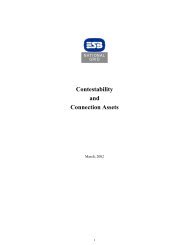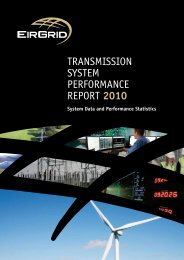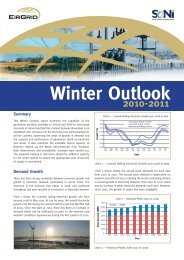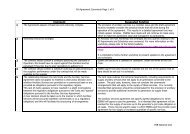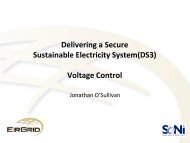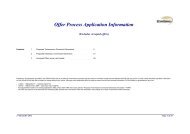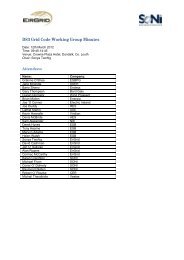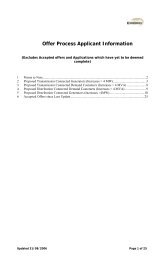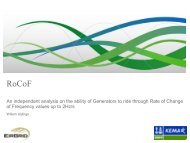DS3 Advisory Council Presentations June 2013 - Eirgrid
DS3 Advisory Council Presentations June 2013 - Eirgrid
DS3 Advisory Council Presentations June 2013 - Eirgrid
Create successful ePaper yourself
Turn your PDF publications into a flip-book with our unique Google optimized e-Paper software.
<strong>DS3</strong> Programme Status Update<br />
19/06/13<br />
Yvonne Coughlan
<strong>DS3</strong> -Critical Phase in terms of delivery<br />
1. System Services<br />
– Decision on System Services<br />
2. Grid Code Changes and<br />
Implementation (incl. RoCoF)<br />
– Some modifications approved<br />
– Others in progress<br />
3. Progressing Distribution Code changes<br />
– Taking Grid Code changes and applying<br />
to Distribution Code<br />
4. Operational Policies<br />
– Minimum No of Units, SNSP
System Services<br />
• TSO Recommendations Paper<br />
published<br />
– May <strong>2013</strong><br />
Transient Voltage Response<br />
Voltage Regulation<br />
Network<br />
• Workshop scheduled – 26 <strong>June</strong><br />
<strong>2013</strong><br />
– Overview of responses to Third<br />
Consultation<br />
– Key Recommendations<br />
• Products<br />
• Contractual<br />
• Remuneration<br />
– Financial Modelling<br />
Dynamic<br />
Reactive<br />
Power<br />
ms – s<br />
Inertial<br />
Response<br />
Steady-state<br />
Reactive<br />
Power<br />
s – min<br />
Reserve<br />
Network<br />
Adequacy<br />
Grid 25<br />
min – hr<br />
Ramping<br />
• Planning for next phase of<br />
System Services dependent on<br />
RAs’ Proposed Decision<br />
SIR<br />
FFR<br />
POR<br />
SOR<br />
TOR1<br />
TOR2<br />
RR<br />
Ramping<br />
0 – 5s 5 – 90s 90s – 20min 20min – 12hr
Grid Code<br />
• Wind Farm Modifications - Ireland<br />
– Approved by CER in Feb 2012<br />
– EirGrid has written to all transmission connected wind farms requesting<br />
confirmation of compliance with new Grid Code standard<br />
• Deadline of 22 May <strong>2013</strong><br />
• Responses now received from all parties<br />
• Responses received do not fully address the technical queries<br />
• No timelines received from wind farm owners<br />
• Derogation requests need to be submitted by 2 nd August <strong>2013</strong> ( to facilitate<br />
review by EirGrid)<br />
– For wind farms without operational certificates<br />
• Existing Process is in place for obtaining Operational Certificates by 1 st<br />
December <strong>2013</strong><br />
• Compliance with New Grid Code Modifications or mitigation actions will be<br />
assessed by TSO (including any derogations)<br />
– For wind farms with operational certificates<br />
• Revert with derogation request or mitigation actions to be taken
Grid Code<br />
• Wind Farm Settings Schedule<br />
– Not approved by UREGNI<br />
• ESBN Distribution Code modifications<br />
– ESBN Distribution Code Review Panel Meeting held on 18 <strong>June</strong><br />
– Ramping, reactive power, fault ride through, voltage control requirements<br />
(similar to Grid Code) for Type A and Type B (some differences)<br />
recommended for approval<br />
– Next Steps: Progress wind farm modifications for other Wind Farm Types<br />
• NIE Distribution Code modifications<br />
– Most requirements are covered in WFPS Settings Schedule<br />
– Unclear how Distribution Code changes are made in Northern Ireland
Grid Code<br />
• RoCoF Modifications<br />
– Generator RoCoF Standard with CER/UREGNI for approval<br />
– Received ESBN report on RoCoF settings (outstanding questions)<br />
– Have not received full NIE report (2 page summary received)<br />
• Dynamic Model modifications<br />
– Joint Grid Code working group meeting scheduled for end July<br />
– Plan to submit a modification for approval in Ireland – Sept <strong>2013</strong><br />
– Working out interaction with WFPS Settings Schedule
Model Development & Studies<br />
• Significant studies underway<br />
– New dynamic models developed by Powertech<br />
• Min Gen Pilot Study<br />
– Initial studies complete<br />
• Validating Frequency Model<br />
– For inclusion in WSAT<br />
– For accurate calculation of RoCoF in real time<br />
• Voltage Studies underway<br />
– Optimisation of voltage control<br />
– Over-compensation/PV analysis
DSM<br />
• Grid Code<br />
– DSU modification Consultation concluded in Northern Ireland<br />
– Ireland DSU modification passed to CER for consideration<br />
– Workshop planned with industry for July<br />
• New communications protocol being trialled<br />
– Secure “Inter Control Centre Protocol” (ICCP)<br />
– Electricity Exchange<br />
• Workshop with existing DSUs and applicants<br />
– Planned for July <strong>2013</strong><br />
– Forum to look at changes/improvements that can be made<br />
• Updated Plan to be provided in Q3 <strong>2013</strong>
Performance Monitoring & Testing<br />
• Enhanced Performance Monitoring workshops<br />
– Held on 6th <strong>June</strong> in Belfast and 11th <strong>June</strong> in Dublin<br />
– 4 <strong>Presentations</strong> on Industry Perspective<br />
– Industry supportive of performance monitoring<br />
• Call for greater transparency and for TSOs to make performance<br />
assessment methodologies available<br />
• Next Steps<br />
– Final comments on performance monitoring - end <strong>June</strong><br />
– TSOs to publish views from workshops – End July<br />
– Follow up workshop on business processes<br />
• Roll out of Enhanced System – Q4 2014
Performance Monitoring & Testing<br />
• Developing sample all island test procedure –<br />
<strong>June</strong> <strong>2013</strong><br />
– Template for other test procedures<br />
• Drafting of other test procedures<br />
– Due to commence Q3 <strong>2013</strong><br />
• Testing Guidelines in draft<br />
– Wind Farm Modifications
Actions from Last <strong>Advisory</strong> <strong>Council</strong> Meeting<br />
Vector Shift<br />
• Have held a meeting with NIE on Vector Shift<br />
• High Level analysis carried out<br />
• Potential Vector Shift Ranges<br />
– 10 - 15 and 3.5 - 9.8 (dependent on specific connection arrangement)<br />
Loss of Largest Infeed<br />
• The largest single electricity source is known as the largest infeed<br />
• System operators maintain sufficient spinning reserve to cover the loss of the largest system<br />
infeed<br />
• Loss of the maximum infeed may not have the greatest impact on system security<br />
– Unit with high inertia carrying significant reserve may have a greater impact<br />
• Also cover “Less Probable Contingencies” (HILP Events)<br />
• New Risk of “loss of Embedded Generation”<br />
• Paper will be published in Q3 <strong>2013</strong>
Operational Limits<br />
• Greater focus on other binding constraints on<br />
system (other than SNSP)<br />
– Investigation underway<br />
– Min Number of Sets (Pilot Study complete – further study planned)<br />
– Inertia (calculating frequency of curtailment)<br />
– Examining estimate of various factors for inclusion in curtailment report<br />
– Update will be given at next <strong>Advisory</strong> <strong>Council</strong> meeting
Relevant Industry Developments<br />
• Gate 3 constraint reports issued<br />
Assumptions<br />
– <strong>DS3</strong> work plans assumed RoCoF workstream fully resolved by the<br />
end of <strong>2013</strong><br />
– Based on above, System Operators expected to increase SNSP to<br />
60% by start of 2014<br />
– Delays now expected to this date<br />
– Re-programming dependent on outcome of RoCoF decision by RAs<br />
– Initial Estimate – Movement of SNSP will be delayed to start of 2015<br />
• Will impact on projected curtailment levels in 2014
Industry Perspective<br />
19 th <strong>June</strong> <strong>2013</strong><br />
Peter Harte
Industry Perspective<br />
19 th <strong>June</strong> <strong>2013</strong><br />
Joe Duddy
RoCoF Update<br />
19 th <strong>June</strong> <strong>2013</strong><br />
Robert O’Rourke
<strong>DS3</strong> Voltage Control Studies<br />
Reactive Power and Wind Farm Clusters<br />
Paul Cuffe
Background<br />
• Wind generation Grid Code modifications:<br />
• Control Modes (Power Factor, Voltage, Reactive Power)<br />
• Reactive Power Capability<br />
• Fault Ride Through Requirements<br />
• New standards will also apply to distribution connected<br />
wind generation (via WFPS setting schedule in Northern<br />
Ireland and Distribution Code modifications in Ireland)<br />
• Study recently undertaken to look at performance of<br />
different control schemes on a sample of distribution<br />
connected wind-farm clusters.
The Questions<br />
• How to use reactive power from wind farm<br />
clusters?<br />
• Will enabling voltage control help at the<br />
transmission level?<br />
• What about tap-changing bulk supply<br />
transformers?
Omagh<br />
Magherakeel110<br />
Magherakeel33<br />
The Networks: Magherakeel<br />
33 kV network<br />
~120 MW of wind<br />
Sending voltage<br />
PCC voltage<br />
G ~<br />
Church Hill 18.4 MW<br />
G ~<br />
Thornog 9.2 MW<br />
G ~<br />
Tievenameen 34.5 MW<br />
G ~<br />
Seegronan 18.4 MW<br />
G ~<br />
Crighshane 32.2 MW<br />
G ~<br />
Meenakeeran 10 MW
Corderry110<br />
2<br />
0<br />
0<br />
0<br />
0 0<br />
0<br />
The Networks: Corderry<br />
Remote bus<br />
Grid<br />
strength Z<br />
20 kV network<br />
~35 MW of wind<br />
G ~<br />
G ~<br />
2<br />
11 km<br />
5.6 km<br />
7.65 km<br />
G ~<br />
0.75 km<br />
0.25 km<br />
0.25 km<br />
G ~<br />
G ~<br />
G ~<br />
Tullynamoyle 9 MW<br />
G ~<br />
0<br />
Altgowlan<br />
7.65 MW<br />
Moneenatieve<br />
4.25 MW<br />
Geevagh 4.95 MW<br />
2.5 km<br />
Carrane Hill<br />
3.4 MW<br />
Black Banks I 3.4 MW<br />
7 km<br />
Black Banks II 6.8 MW
Study approach<br />
• Many simulation cases:<br />
– Power factor regimes<br />
– Voltage control modes<br />
– Active control schemes<br />
• Load flow every minute over test month<br />
• Re-tap transformer if voltage deviation persists<br />
for two minutes
M’keel results: Taps
M’keel results: Losses
M’keel results: Voltage control
M’keel results: Effect of droop<br />
Transmission<br />
voltage<br />
(kV)
M’keel results: Effect of droop<br />
Transmission<br />
voltage<br />
(kV)
M’keel results: Effect of droop
M’keel results: P, Q, V<br />
Wind Output (MW) →<br />
120<br />
115<br />
110<br />
105<br />
100<br />
95<br />
90<br />
85<br />
80<br />
75<br />
70<br />
65<br />
60<br />
55<br />
50<br />
45<br />
40<br />
35<br />
30<br />
25<br />
20<br />
15<br />
10<br />
5<br />
0<br />
110.5<br />
+16<br />
Inject<br />
Average MVAr at M'keel110<br />
Absorb<br />
-16<br />
111.5<br />
112.5<br />
113.5<br />
114.5<br />
M'Keel110 voltage (kV) →<br />
115.5
M’keel results: Smart power factor
Corderry results: Losses
Corderry results: Taps
Corderry results: Voltage control
Corderry results: Active and reactive<br />
flows
Wind Output (MW) →<br />
Average MVAr at<br />
Corderry110<br />
Corderry results: P, Q, V<br />
Corderry110 voltage (kV) →<br />
114.5<br />
115.5<br />
116.5<br />
117.5<br />
118.5<br />
119.5<br />
35<br />
30<br />
25<br />
20<br />
Absorb<br />
-8<br />
15<br />
10<br />
5<br />
0<br />
+8<br />
Inject
Corderry results: Active control
Corderry results: Smart power factor
Performance Summary<br />
• Performance achievable is dependant on each distribution<br />
network<br />
• Transmission system reactive power requirements vary by<br />
location<br />
• A number of options are available, and it probably isn’t onesize-fits-all
Next Steps<br />
• These studies focused on the performance of two sample<br />
embedded wind-farm clusters. Further analysis is<br />
underway to determine the wider transmission system<br />
impact (Q4 <strong>2013</strong>).<br />
• The TSOs and DSOs are to work together on further<br />
consideration of control arrangements and their<br />
implementation – further planning of the work in this area is<br />
required.<br />
• Ultimately an agreed TSO/DSO reactive/voltage control<br />
protocol is envisaged (Q4 2014).
System Services Update<br />
19 th <strong>June</strong> <strong>2013</strong><br />
Michael Preston
TSO Recommendations Paper<br />
• Paper sent to the RA’s in late April<br />
– Delayed by 4 weeks due to additional time and materiality of the<br />
responses<br />
• Paper published on the TSO’s websites on 24 th May <strong>2013</strong><br />
• Engagement with RA consultants Poyry in last three weeks
Principle Recommendations<br />
• The system service products are, in so far as possible,<br />
technology neutral.<br />
• Price regulation based on value approach informed by<br />
incremental capital cost and allocated by relative service<br />
approach option 3.<br />
• Flat tariff, fixed for at least 5 years.<br />
• New system services:<br />
– Synchronous Inertial Response<br />
– Fast Frequency Response Ramping (1, 3 and 8 hour)<br />
– Fast Post Fault Active Power Recovery Dynamic Reactive Power.
Detailed Recommendation<br />
• System service rates should be determined by the<br />
recommended approach.<br />
• The total benefit from System Services is €355 million and<br />
should be used to determine the product tariffs to be<br />
employed from 1 st Oct 2015.<br />
• The determination of how these revenues interact with<br />
Capacity Payments is a matter for the SEMC.
Recommendation for further<br />
consultation<br />
• The exact portfolios and methodology to be used in<br />
determining the allocation between system services.<br />
• The System Services contract framework including<br />
termination clauses.<br />
• The process and implementation details for determining<br />
the performance scalars.<br />
• The details associated with the implementation of the<br />
products and their remuneration.<br />
• The process for determining and setting the rate scalars<br />
(including reference price).
Next Steps<br />
• May- <strong>June</strong> Working with RA consultants Poyry<br />
• <strong>June</strong> 26 th System Services Forum to clarify and explain TSO<br />
recommendation<br />
• <strong>June</strong> TSO make short presentation to SEMC<br />
• July <strong>2013</strong> - SEMC proposed decision to be issued following<br />
Poyry report<br />
• Sep <strong>2013</strong> - SEMC High level decision to be issued<br />
• Phase 2 begins
Curtailment Report 2012<br />
19/06/<strong>2013</strong><br />
Jon O’Sullivan
Results for 2012<br />
• EU legal obligation (Art 16 RES Directive)<br />
• SEM 011-62<br />
– Hierarchy used based on VPTG<br />
• Operational Issues of Note<br />
– Turlough Hill (Refurbishment)<br />
• EWIC- no counter-trading in 2012
Jurisdictional Breakdown 2012<br />
IRE NI All Island<br />
Total RES-E 17.3% 12.5% 16.5%<br />
Dispatched Down<br />
Wind (GWh)<br />
Dispatched Down<br />
Wind (%)<br />
Dispatched Down<br />
VPTG Wind<br />
(GWh)<br />
103.1 7.2 110.3<br />
2.5% 0.7% 2.1%<br />
80.9 7.2 88.1
Ireland- Dispatch Down of Wind 2012
N. Ireland- Dispatch Down of Wind 2012
All-Island Dispatch Down of Wind 2012 (by<br />
Hour of Day)
VPTG Dispatch Down by Region
All-Island High SNSP Reports<br />
2012<br />
David Cashman<br />
<strong>DS3</strong> <strong>Advisory</strong> <strong>Council</strong> Meeting<br />
19 th <strong>June</strong> <strong>2013</strong>
Wind Statistics<br />
• Capacity Factor 2012: 28.5%<br />
• All-Island Wind Generation<br />
record of 1875 MW on<br />
December 18 th 2012 (SNSP<br />
48.11%)<br />
• On December 28 th wind<br />
accounted for 37.3% of demand<br />
• Maximum recorded SNSP: 50%<br />
50%<br />
45%<br />
40%<br />
35%<br />
30%<br />
25%<br />
20%<br />
15%<br />
10%<br />
5%<br />
0%<br />
2012 Monthly Wind Capacity Factors<br />
Jan Feb Mar Apr May Jun Jul Aug Sep Oct Nov Dec<br />
• 49 Days in 2012 where wind<br />
exceeded 40% of demand
All-Island High SNSP Reports<br />
• Snapshot of the All-Island System taken<br />
– High Wind<br />
– High SNSP<br />
– Low Inertia<br />
– Low Inertia relative to size of Largest In-/Out-feed<br />
• Voltage Stability<br />
– Power transfer analysis<br />
• Frequency Response<br />
– Fault followed by Loss of In-/Out-feed<br />
• Critical Clearance Time<br />
– Angular stability
All-Island WSAT<br />
• Moved from Ireland-only to all-island model in<br />
November 2012<br />
• Currently used in both Control Centres for<br />
voltage and transient stability analysis<br />
• Programme of continuous improvement is<br />
underway with a view to employing the<br />
frequency stability analysis capabilities of WSAT<br />
in both Control Centres<br />
• Comparison against real events
Frequency (Hz)<br />
All-Island WSAT Frequency Response<br />
50.1<br />
Frequency Comparison - Event 4 - DB1 trip from 379 MW<br />
50.0<br />
49.9<br />
49.8<br />
49.7<br />
49.6<br />
49.5<br />
TSAT<br />
PMR<br />
49.4<br />
49.3<br />
49.2<br />
-1 4 9 14 19 24<br />
Time (s)
Analysis of All-Island High SNSP<br />
Reports - 2012<br />
• All-Island WSAT model became available off-line in August 2012. 28<br />
reports compiled between August and year end 2012<br />
• At the beginning of <strong>2013</strong> a summary document was compiled outlining the<br />
major findings and operational recommendations in relation to transient,<br />
voltage and frequency stability.<br />
• To date results do not demonstrate any voltage or transient stability issues<br />
at current levels of SNSP.<br />
Date SNSP % Voltage<br />
Stability<br />
Transient<br />
Stability<br />
26-08-12 50<br />
26-09-12 49<br />
20-11-12 46<br />
19-12-12 50<br />
22-12-11 50
Analysis of All-Island High SNSP<br />
Reports - 2012<br />
• Simulate 3-phase fault at HV terminals of generator followed by<br />
tripping of generator (highly onerous and low probability)<br />
• RoCoF measured over 500 ms as per proposed Grid Code<br />
modification<br />
• Investigating System Separation<br />
Date SNSP % Fmin Hz RoCoF Hz/s<br />
no Fault<br />
26-08-12 50 49.6 0.21<br />
26-09-12 49 49.5 0.36<br />
20-11-12 46 49.5 0.22<br />
19-12-12 50 49.5 0.28<br />
22-12-11 50 49.5 0.22
Analysis of All-Island High SNSP<br />
Reports - 2012<br />
• Simulate 3-phase fault at HV terminals of generator followed by<br />
tripping of generator (highly onerous and low probability)<br />
• RoCoF measured over 500 ms as per proposed Grid Code<br />
modification<br />
• Investigating System Separation<br />
Date SNSP % Fmin Hz RoCoF Hz/s<br />
no Fault<br />
RoCoF Hz/s<br />
with Fault<br />
26-08-12 50 49.6 0.21 0.42<br />
26-09-12 49 49.5 0.36 0.55<br />
20-11-12 46 49.5 0.22 0.43<br />
19-12-12 50 49.5 0.28 0.51<br />
22-12-11 50 49.5 0.22 0.43
RoCoF Measurement<br />
3φ faults at HV busbar followed by loss of generator or interconnector
Outcomes and next steps…<br />
• Investigating the boundaries of operation<br />
• Ensure correct protection settings on all transmission- and<br />
distribution-connected wind farm models<br />
– RoCoF relay model should be reflective of actual relay<br />
– Relay models should contain actual over- and under-frequency settings<br />
• Investigate developing operational policy based on the ratio of<br />
System Inertia to Largest Infeed or Outfeed<br />
– Current Policy to monitor inertia from 25000 MWs and maintain above<br />
20000 MWs<br />
– Inertia and Largest Infeed related to the RoCoF<br />
– Aim to develop policy linking Largest Infeed or Outfeed to inertia<br />
requirement<br />
• Investigate accuracy of generator and load models
System Services Discussion<br />
Jon O’Sullivan<br />
19 th <strong>June</strong> <strong>2013</strong>
Minimum Number of Units Study<br />
(Pilot Results)<br />
19 th <strong>June</strong> <strong>2013</strong><br />
Ivan Dudurych
Objective and Methodology<br />
• The Objective of the Study is to define a Minimum number of<br />
Conventional Units (MNU) needed to stay on the system to insure<br />
that Operational Security Standards (OSS) are maintained.<br />
• Conventional Units set under consideration includes all big CCGT<br />
and Moneypoint units.<br />
• Components of OSS monitored: Frequency, Transient and Voltage<br />
Security, and Operational Reserve<br />
• From on-line WSAT we selected 12 snapshots to create 28 high wind<br />
cases representing various system conditions during minimum load<br />
• These cases were subjected to further wind power increase balanced<br />
by conventional generation decrease while making sure that OSS are<br />
maintained. In such a way MNU has been established for each of the<br />
cases.<br />
• Note: System Separation was not analysed in this Pilot study
Main factors influencing the Minimum<br />
Number of Units<br />
• The value of the largest in-feed<br />
• Turloughill units mode of operation<br />
• RoCoF settings of DSO-connected wind<br />
• Availability of operating reserve, including static reserve (at Moyle<br />
and/or EWIC)<br />
• Interconnectors flows<br />
• Note: The local wind-related N-1 overloads (mostly North-West) can<br />
limit wind and thus potentially increase required number of<br />
conventional generators in the individual case
Summary of Pilot Studies<br />
• 8 Set rule is generally sound for all traditional<br />
configurations<br />
• Less than 8 sets is possible but only in certain<br />
circumstances<br />
• Developing a robust rule set requires robust<br />
studies<br />
• Some issues identified for 8 set rule in non<br />
traditional configurations
Next Steps – Full Study<br />
• Additional 50 representative cases will be analysed using the same<br />
methodology and criteria as in a Pilot Study.<br />
• System Separation will be included as a contingency in the study<br />
• Ramping requirements will be included as additional component of<br />
OSS<br />
• Impact of local overloads will be assessed<br />
• A set of tables defining the minimum number of units in a range of<br />
operating conditions will be created<br />
• Full study results will inform a new Min Gen Policy
<strong>DS3</strong> <strong>Advisory</strong> <strong>Council</strong> Review<br />
19 th <strong>June</strong> <strong>2013</strong><br />
All



